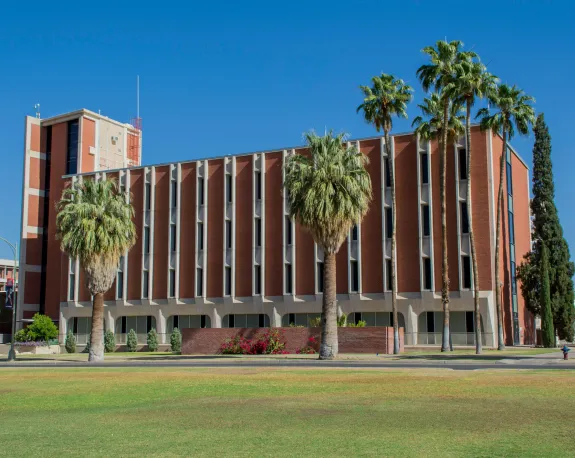
About LPL
Learn about our academic, research, and outreach programs, find contact information and maps, and read about LPL's history in planetary science.
Welcome from Mark Marley, Department Head and Laboratory Director

Welcome to the University of Arizona’s Department of Planetary Sciences (PTYS) and Lunar and Planetary Laboratory (LPL). Let me tell you a little about this institution.
LPL was founded in 1960 by planetary astronomer Gerard P. Kuiper, after whom the Kuiper Belt of icy objects in the outer Solar System and the Kuiper Prize (the top honor of the world’s largest organization of planetary scientists) are named. Most of the original work was based on observations using telescopes, but as the exploration of the planets expanded in scope, so did LPL. In 1973, the Department of Planetary Sciences was formed, to educate succeeding generations of planetary scientists. Indeed, I'm proud to be a graduate of the program myself.
Our dedicated faculty, research staff, and students come from a variety of backgrounds, including physics, astronomy, geosciences, chemistry, and engineering, but have a common interest in planets. In fact, the interdisciplinary nature of planetary science is one of its appeals for many of us, as we have to learn something of many of those other disciplines just to communicate, not to mention to succeed in understanding what is happening on, in, around, and between planets. Now, with the discovery of thousands of extrasolar planets, LPL is bringing that same interdisciplinary focus to understand whole new classes of worlds.
LPL’s expertise has also broadened as the field has expanded: some of us still use telescopes, others work with spacecraft, others work in laboratories analyzing extraterrestrial materials like meteorites or simulating the conditions on the planets, and still others primarily work on the theoretical work required to explain all the observations. The list of objects we study has broadened, too. When LPL was founded, Kuiper had proposed a belt of objects orbiting beyond Neptune, but none (except Pluto) had been found—now we study the Kuiper Belt and Kuiper Belt Objects. Only a few asteroids were known at the time—our asteroid survey programs have discovered hundreds of thousands, and we are leading OSIRIS-REx, a spacecraft mission to an asteroid. No planets orbiting stars other than the Sun were known until the 1990s—now research on exoplanets is a large part of what we do.
The University of Arizona is one of the nation’s best research universities, annually ranking among the top in the nation in external financial support for research in the physical sciences. LPL is comparably highly ranked. In the June 2025 ranking by U.S. News & World Report (list of best global universities for space science), the University of Arizona, led by research and publications from LPL and Steward Observatory, was ranked No. 4 globally and No. 2 among U.S. public universities in space science research, based on our strong research reputation and publication frequency. The NSF Higher Education Research and Development survey ranks the U of A, led by LPL and Steward Observatory, at or near the top of all universities in space science research and development expenditures, a ranking we have held since 1987.
We have a commitment to education. Through the PTYS department, we teach courses ranging from General Education courses on basic science for incoming university freshmen to research seminars for advanced graduate students. The vast majority of our Ph.D. graduates have remained in the field of planetary sciences, with faculty positions or research jobs at NASA and various private institutes, and many of them are among the international leaders in the field. In addition to formal classes, we host the campus-wide Teaching Teams Program and the state-wide Arizona Space Grant Consortium.
We also believe that hearing from many different voices in our community is important, as the strongest planetary science arises by studying a planetary science topic from many perspectives. Our graduate student population is consistently half female and half male. While there is room for improvement in other areas and at other levels, we continue to strive for more diversity, because we believe that hearing different types of voices is as important as utilizing different academic traditions.
Please browse through our website, learn about our history, and find out some of the amazing things our faculty, staff and students are doing in the fast-developing field of planetary sciences.
Our Mission
The Lunar and Planetary Laboratory (LPL) is a world leader in space science, technology, and exploration, and committed to advancing the fundamental understanding of the origin and evolution of the Sun, planetary bodies in our solar system and in other planetary systems. We achieve excellence through cutting-edge research and teaching, as well as through mentoring the next generation of planetary scientists. Planetary science is a multidisciplinary and interdisciplinary endeavor and LPL encourages the growth of a community that advances science, technology, engineering, and math research, education, and public engagement, where everyone can thrive.
LPL at a Glance
Overview of LPL's academic program, current research and active missions, and public outreach initiatives.
About UA & Tucson
Information about the University of Arizona, the City of Tucson, and the unique amenities, resources, and opportunities available for faculty, staff and students.
Community
LPL is committed to fostering a workplace environment and culture in which all members feel that they belong and can participate in our scientific community knowing they will be seen, heard, and respected.
Contact Info/Maps
Maps and contact information for LPL's three locations in Tucson: Kuiper Space Sciences, Sonett Space Sciences, and the Drake Building.

